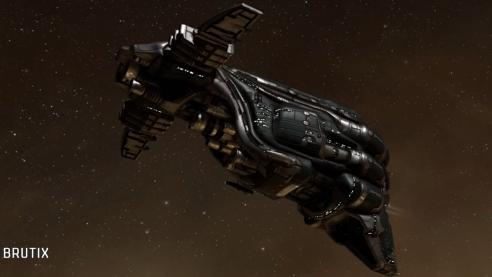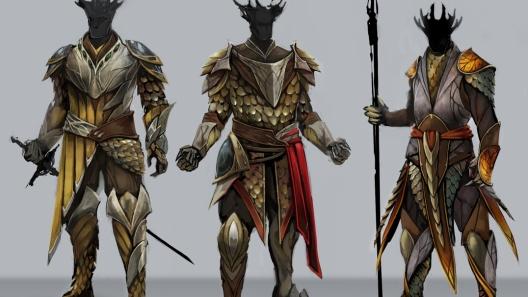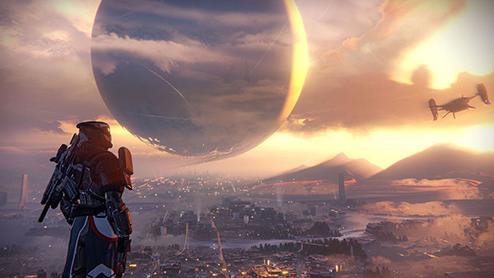graphics
Latest

NVIDIA brings its top-end desktop graphics to laptops
You no longer need a huge, water-cooled rig to play the latest blockbuster shooters, with plenty of gaming laptops doing a fine job of marrying performance with portability. But a divide still exists, with even the best mobile GPUs defined as "desktop-class," which is a nice way of saying they aren't quite as powerful as the cards made for home office-hogging towers. That said, in what NVIDIA claims is an industry first, the company has today announced its top-end GeForce GTX 980 desktop GPU is headed to laptops. Not to be confused with the GTX 980M -- NVIDIA's previous flagship GPU for notebooks -- the GTX 980 for laptops is exactly the same as the desktop version, offering identical gaming performance.

AMD spins off Radeon graphics into new division
AMD has formed a new Radeon graphics division and put its highly-regarded CTO, Raja Koduri, in charge. The Radeon Technologies Group will run quasi-independently of AMD with the goal of recapturing market share from NDVIDIA and "staking leadership positions in new markets such as virtual and augmented reality," according to CEO Dr. Lisa Su. Koduri is a key figure in the graphics industry who developed the first DirectX 9 graphics cards. He later helped Apple build its Retina program during a tenure as graphics CTO before returning to AMD in 2013.

Old Atari games had graphics glitches because of CPU bottlenecks
Now that we know how the graphics worked on the Nintendo Entertainment System and Commodore 64, The iBookGuy wants to tell us all about how the Apple II and Atari 2600 got their groove on. In the latest video he says that the Apple II actually used two different techniques for producing visuals depending on whether you had a monochrome or color monitor unit. And the reason white text on a black background appears almost rainbow-like in nature on color machines has to do with pixel placement. For example, blue and green being next to each other on screen requires perfect alignment lest you want white mages to have spots of the former bleeding into them.

Pixar will open-source the code for a key movie-making tool
Fancy that you could create the next Inside Out if you only had the right tools? Pixar just made that dream a little more realistic. Mere months after giving away Renderman, the studio has announced plans to open the source code for its Universal Scene Description software, which gives multiple computer animation apps a common "scene graph" to work from. It should help movie makers streamline the production process (particularly if there's more than one company involved), but it'll also be a boon to animation app designers who want their various programs to play together.

Your Android games are getting a software speed boost
iPhone users have low-level Metal code to speed up games and other visually intensive apps, but what if you're an Android fan? Don't worry, you'll get your boost soon. Google has announced that Android will soon support Vulkan, an open graphics standard that cuts a lot of the computing overhead and gives apps more direct control over video hardware. It's not as easy to work with as OpenGL, but it should let developers wring more performance out of your phone's processor. That could prove very important when you'd otherwise struggle to run a game on a lower-end phone, or want to get pretty, high-detail graphics on a shiny new flagship. It'll be a while before Vulkan for Android is ready -- the standard itself isn't available, let alone Google's implementation of it -- but it should be worth the wait if your Android devices double as game consoles.

Apple will fix your older MacBook Pro's video problems for free
Did you snag a MacBook Pro before 2014 only to run into corrupted video, no video at all or spontaneous reboots? You won't have to shell out for a fix if you're out of warranty. After more than a year of reports, Apple is launching a repair program that will mend your laptop for free if its graphics are going haywire. You're covered so long as you bought a 15- or 17-inch MacBook Pro between early 2011 and the end of 2013, including the first two generations of Retina models. The program will be available as of February 20th if you're in the US or Canada, and a week later in the rest of the world. Only a "small percentage" of systems are affected, Apple says, but it won't hurt to check coverage even if everything is hunky dory.

ARM's latest processor design puts fast 4K graphics on your phone
You've probably heard no end of hype for 4K video on TVs and computers, and now it's about to invade your phone... at least, so long as ARM has its way. The company just took the wraps off of Cortex-A72, a processor reference design that promises a huge boost to computing power, especially when graphics come into play. Thanks to updates that include optimizations for an efficient 16-nanometer chipmaking process, 30 percent more memory performance and an 80 percent speedier graphics core (the Mali-T880), the A72 is about 3.5 times more powerful than ARM's earlier Cortex-A15. That's beefy enough to record 4K video at an extra-smooth 120 frames per second -- many current smartphones only manage 30FPS at best. You should get "console-class" gaming, too, and there's a promise of Google Now-style natural voice commands that don't depend on a distant server to interpret what you're saying.

The Repopulation drops its first patch for the new build
It's more possible to play The Repopulation now than it has ever been, and that means the design team is shaking up how it handles updates. Instead of the monthly recaps of the past, the team is putting forth notes for each individual patch, such as the first major one to hit the current testing build. It's focused on improving several areas of the game, starting with a polishing of textures and performance in Plymouth City and a few other smaller points. Several combat improvements have also been rolled out, although the next patch will hit most of the major combat issues players have brought up. Skill gain rates have also been adjusted, as have the Auction and Work Order systems in hopes of keeping the economy lively. If a few lingering issues had kept you from fully enjoying The Repopulation or you just want a picture of all the changes that have come down the pipe, check out the full walkthrough of the latest patch.

Diablo III to begin technical testing in China shortly
If you're a gamer in China waiting for Diablo III, you have undoubtedly been waiting for a very long time. Given the game's subject matter and the strict censorship policies of the government, it's not a surprise that it's taken a while to get moving. At long last there is a light at the end of the tunnel, however, as distributor Netease has announced that the censorship issues are finally resolved and the game is free to begin technical testing. The testing phase will begin after the lunar new year is celebrated later this month. While the exact nature of graphical changes has not been disclosed, Netease stresses that the game will still be cool to look at, which could mean... almost anything, really. Still, at this point most of the players who have long waited for the game will just be happy to see it finally available within China.

The Big Picture: 3D Paris apartment shows what Unreal Engine 4 can do
See that room above? It looks real, but it's not -- and by that we mean it's just a 3D environment made in Unreal Engine 4. Sure, we already have a pretty good idea what the new engine can do, such as bringing realistic skin (among other things) to games. But this "Unreal Paris" project by CG designer Dereau Benoît proves that it can be used to create objects and environments that look more like photographs of the real thing rather than CG. Benoît has created a snazzy Parisian apartment with receiving rooms, dining area, kitchen, bedroom, hallways and even a full bathroom.

NVIDIA's car of the future drives itself, has a gorgeous digital dashboard
In-dash navigation and instrument clusters don't need to be pretty, but when they are, it's a bonus. Case in point: NVIDIA's new Drive CX platform. The digital dashboards look pretty snazzy thanks to the company's graphics heritage, with the surfaces for the gauges following the properties of the materials they're simulating. Meaning, not only do the bamboo or carbon fiber skins look like a version of the real McCoy from head-on, but they also reflect light and color in ways that the actual material would in the real world, too. NVIDIA says this is all possible thanks to the newly unveiled Tegra X1 processor.

CCP dev blog talks PBR and 'making EVE look real'
Have you ever wondered about the math behind the visuals in your favorite games? If so, look no further than the latest EVE Online dev blog, which regales us with tales of the Phong Reflection Model and how it's giving way to something called Physically Based Rendering or PBR. The post features a bunch of equations, literally, and plenty of associated smart-person talk. Fortunately for me it also features quite a few pretty pics of internet spaceships! You can read it for yourself via the links below.

EVE Online's Rhea update launches with photo-realistic spaceships
The many sleek and styling spaceships of EVE Online are about to get a visual upgrade with today's Rhea update, thanks to something called physically-based rendering. By applying this tech, spaceships will have "a natural, photo-realistic look." Of course, when it comes to visuals, they must be seen or they didn't happen. So see! After the break, that is. CCP says that this new tech will be initially limited to spaceships but eventually will be used on stations and other space objects. You can also check out the patch notes for Rhea as well.

Final Fantasy 13 gets 1080p support on Steam next week
Square Enix will introduce a patch for Final Fantasy 13 on Steam next week that will give players additional graphics options. Slated to land on Thursday, December 11, the update will allow players to switch to custom resolutions, such as 720p and 1080p. The patch hits the same day that the game's sequel, Final Fantasy 13-2, will arrive on Steam as well. Final Fantasy 13 first launched in late 2009 in Japan, making its worldwide debut in March 2010 for PlayStation 3 and Xbox 360. The game was followed by the aforementioned 13-2 in February 2012 and the final game of the trilogy earlier this year, Lightning Returns: Final Fantasy 13. Those planning on picking up the Steam version of Final Fantasy 13-2 may want to pre-purchase the game, as it is 10 percent off at the moment ($17.99). [Image: Square Enix]

Why updated graphics matter
What you see above is the result of time marching on - in my draenei's right hand is Sulfuras, the Extinguished Hand, a drop from Firelands. In the left hand, Sulfuras, Hand of Ragnaros, the legendary drop from the original Molten Core. (Yes, I know technically it doesn't drop, the Eye drops, you craft a Sulfuron Hammer and then use the Eye on it, I've had the thing since MC I know how I got it.) What I'm showing you is essentially the orderly progression of time via graphic upgrades - you can essentially see the history of the game unfolding via the difference between these two weapons. Everything from the spikes to the grip to the shape of the head, it's all more detailed and crisp on the newer model. The older model is a collection of polygonal shapes that bear only a vague resemblance to a hammer compared to the newer model, which is itself still not as good as models we have in the game now, never mind some of the Warlords drops we're about to see. The gap between these two hammers is the gap between 2004 and 2011, and here we are, three years later than that - and they show us how much a ten year old game can in fact change.

Camelot Unchained explores the designs of the Tuatha De Danann
Armor is not a fashion statement. Well, all right, it usually is, but it's not just a fashion statement. How a race looks in a given game often says a lot about what that race represents and what matters to the members as a whole. Camelot Unchained's latest update talks about the Tuatha De Danann, both a concept that the team may use for the realm's armor and the updated visual design of the Baen Sidhe. Unlike the design for the Baen Sidhe's previous more macabre appearance, the updated design is still ethereal whilst being less overtly malformed. The scars and wounds that led to the death of an individual Baen Sidhe's line still play into the designs via shadowed tattoos. Meanwhile, the Tuatha De Danann as a whole are so in tune with the seasons and the flow of the natural world that several concept designs for season-themed armors are shown. If you want to see how you can protect your character while still making a fashion statement, check out the full update.

Ascent: The Space Game's Kickstarter will fund updated graphics
When we last checked in on Ascent: The Space Game, the indie sci-fi sandbox MMORPG was already eminently playable, having launched on Desura and angling for a Steam greenlight. Now Fluffy Kitten Studios has posted a Kickstarter intended to fund specific upgrades for the game -- specifically, improved graphics and UI. In fact, the complete budget breakdown is provided on the Kickstarter page. Backer rewards include premium access time, credits, Steam keys, and ships. You could even get a planet named after you. The Ascent sandbox emphasizes freedom, colonization, exploration, trade, combat, farming, mining, ship customization, starbases, and co-op play with fully consensual PvP. The Kickstarter boasts of the game's 270 billion star systems. Massively spoke to James Hicks, founder and CEO of Fluffy Kitten Studios, back in April, when he explained to us his business model, his target audience, and how he's come so far by himself. As he put it then, "Have a look at what we've done, with one developer, in one year, on a shoestring budget for art, music, and sound. Do you want to see what we can do in another year, with more?" The Kickstarter seeks $35,000 and is already at 51% of its goal with 25 days to go as of the time of this writing.

The new Unreal Engine will bring eerily realistic skin to your games
It hasn't been hard to produce realistic-looking skin in computer-generated movies, but it's much harder to do that in the context of a game running live on your console or PC. That trip to the uncanny valley is going to be much easier in the near future, though, thanks to the impending arrival of Unreal Engine 4.5. The gaming framework adds subsurface light scattering effects that give digital skin a more natural look. Instead of the harsh visuals you normally get (see the pale, excessively-shadowed face at left), you'll see softer, decidedly fleshier surfaces (middle and right). The scattering should also help out with leaves, candle wax and other materials that are rarely drawn well in your favorite action games.

EVE Evolved: Features coming in Oceanus and beyond
It's been almost four months since EVE Online switched from publishing two major expansions per year to releasing ten smaller updates, and so far it looks like the new schedule has been a huge success. Rather than forcing the industry overhaul out the door in Kronos before it was ready, CCP was able to push it forward to the Crius release window seven weeks later and the extra development time meant the feature launched in a very polished state. It may be too early to tell if the new schedule's success can be seen in the concurrent player graph for Tranquility, but the numbers have remained steady for the past few months in what is typically the annual low-point for player activity. The Oceanus update is scheduled to go live in just two day's time, adding several graphical upgrades, more difficult burner missions, an experimental new notification feature, and other small improvements. The scale of the update seems to be on par with the recent Hyperion release, consisting of mostly small features and minor iterations on gameplay. While we're told that CCP is still working on large projects behind the scenes, the new release schedule means they won't be rushed out the door and so we may not see them for some time. In this edition of EVE Evolved, I summarise everything we know about Tuesday's Oceanus update, and take a look at what's to come in further releases.

Destiny beta comparison: PlayStation 3 versus PlayStation 4
Though the PlayStation 4 has been soaking up the majority of the spotlight, the Destiny beta is also available on the PlayStation 3, and based on this side-by-side graphical comparison, the older hardware does an admirable job of keeping up. While the PlayStation 3 game runs at a lower resolution and features less detail than its PlayStation 4 counterpart, the broad graphical strokes remain the same. Characters bear the same futuristic, decidedly Halo-esque aesthetic in both games, and actual game content appears to be the same, down to the infamous, ominpresent Peter Dinklage voiceover. Most impressively, the PlayStation 3 beta does an admirable job of providing a stable, fluid framerate, even when the screen is filled with explosive graphical effects. Obviously the PlayStation 4 version of Destiny looks and performs better than its PlayStation 3 counterpart, but if this comparison is any indicator, the older generation of hardware offers a perfectly suitable Destiny experience. [Image: Activision]











